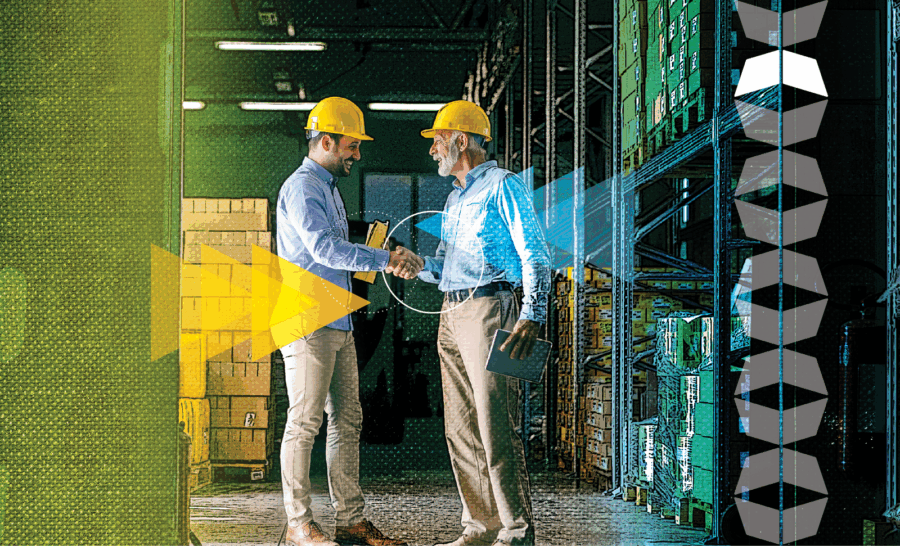Choosing the Right Manufacturing 3PL Partner
Manufacturing supply chains face unprecedented margin pressure. Nearshoring initiatives, tightening regulatory requirements, and fluctuating production schedules also leave little tolerance for disruption. Strategic manufacturers understand that 3PL selection is a critical procurement decision that impacts their reputation and bottom line. Rather than focusing on cost per pallet, industry leaders evaluate operational capability, compliance depth, and scalability under pressure. The difference between manufacturing logistics success and failure often lies in their approach to selecting logistics partners.
Why the right manufacturing 3PL matters
How do you choose the right manufacturing 3PL provider? The answers may vary depending on who answers, but it often comes down to what matters most. While it’s nice to have cultural and vision alignment, what’s most important in today’s logistics? Some things to consider are:
- Reputation: Does the 3PL have a long history in handling raw materials and display the correct industry know-how. Do they understand and have solutions for things such as logistics challenges in regional manufacturing.
- Expertise: Does the 3PL have the right people and infrastructure to navigate the manufacturing supply chain.
- Scalability: If operations grow or change, does the 3PL have the network, partnerships, and locations to adapt or expand operations swiftly.
- Technology: Does the 3PL have modern logistics technology that provides visibility, automation, business insights, and integrations.
- Customization: Does the manufacturing 3PL provider offer one-size-fits-all services or are they willing to tailor solutions to meet a manufacturer’s needs.
Here’s one universal truth: the right manufacturing 3PL service will be able to deliver on your key metrics and add value where it matters. Choose well, and you gain more than a vendor; you gain a growth partner.
This is especially true in manufacturing, where logistics protects production schedules, ensures quality, and meets demand without disruption.
A deeper dive into manufacturing industry experience and track record
A recent study of 187 manufacturers found that companies using structured, multi-factor 3PL vetting frameworks had 35% higher satisfaction and 64% fewer service disruptions in their first year. That’s because a 3PL manufacturing partner should protect your margin, velocity, and reputation.
It’s crucial to understand the depth of a logistics provider’s manufacturing experience. Moreover, it isn’t simply about how long a manufacturing 3PL has been in business but also if and how they’ve solved manufacturing logistical challenges before.
While many supply chain challenges span industries, not all experience transfers. A 3PL with decades in retail ecommerce or FMCG may falter in industrial manufacturing, where logistics involve heavy, regulated, or high-risk materials like steel tubing, hazmat chemicals, or paper rolls that require specialized handling, sequencing, and compliance protocols.
When evaluating potential 3PL manufacturing providers:
- Insist on evidence tied to your category. If you ship engineered metal parts, ask when they last handled materials over 500kg. If you deal in perishables, ask about FDA audits, cold chain excursions, or pallet-level temperature traceability.
- Secret-shop one of their manufacturing clients. Place an order or coordinate a shipment. Evaluate packaging, transit time, and communication. Execution under real conditions reveals more than case studies.
- Ask for their disaster playbook: What’s their protocol for labor strikes, downtime, or weather disruptions? Do they run continuity tests? Can they show how they handled a major line failure?
- Request a postmortem. Ask for an example of a real disruption and how it was resolved. If they can’t show this or hide behind NDAs, consider it a red flag.
Providers unfamiliar with your category often underestimate complexity, mishandle exceptions, and prolong resolution. When researching manufacturing 3PLs, take the time to assess the following capabilities thoroughly:
Compliance and risk management
Manufacturers need a manufacturing 3PL partner with process-level execution experience that maps to your regulatory and operational risk profile. That includes batch tracking for serialized inventory, chain-of-custody for controlled substances, temperature logs for sensitive goods, and documented SOPs for labeling, palletizing, and lot segregation. These are not textbook tasks but compliance critical.
In manufacturing, a single misstep in execution can trigger a recall, missed delivery, or worse, a non-compliance fine. According to ETQ’s Pulse of Quality in Manufacturing survey (2024), 73% of companies experienced a product recall in the last five years, with financial damages averaging $99.9 million per incident in the U.S. Firms also cited secondary effects like plant shutdowns, delayed product launches, layoffs, and reputational damage.
“We’re compliant” isn’t enough. You need proof: embedded traceability, audit trails, proactive issue flagging. Dashboards don’t cut it without the controls behind them. Two simple ways to pressure-test a manufacturing 3PL’s compliance discipline are:
- Shrinkage and inventory audit rate: Ask for inventory accuracy and audit frequency. For regulated or serialized SKUs, poor control equals high risk.
- Use the ‘Walmart Readiness’ filter: Can they meet big-box SLAs with 98% fill rates and EDI compliance? If not, they won’t meet the rigor of manufacturing demands.
Even with airtight compliance, a manufacturing 3PL provider still needs to support your production flow without bottlenecks. They should have the right infrastructure and operational scalability in place.
Infrastructure access
For manufacturers, infrastructure is what keeps production moving. Yet most 3PLs treat warehousing as static storage, not a strategic supply chain enabler. The right infrastructure and manufacturing 3PL partner can compress lead times, improve inbound velocity, and enable just-in-time coordination across production nodes.
This has become even more urgent with the rise of nearshoring, especially in the US, where trade tensions, pandemic disruption, and policy shifts have pushed manufacturers to shorten and regionalize their supply lines. That shift brings new pressure: real estate now acts as both the anchor and the constraint in your supply chain design. If a manufacturing 3PL can’t support those shifts with flexible site selection, regional coverage, or hybrid facility models, they’re not equipped for today’s logistics realities; because let’s face it, location matters.
Ask if a potential manufacturing 3PL provider can co-locate near suppliers. Can they offer multi-node coverage aligned with your production and distribution map? If not, you’re designing around their limitations.
Real estate fluency goes beyond lease terms. A strategic partner assesses floor load capacity, temperature zones, rail access, hazmat compliance, and more. For example, Krueger Lumber Co. struggled with a 250-mile dray to the nearest public rail terminal, costing more than the ocean freight from Chicago to China. WSI stepped in not with new construction, but with smart network design: they rerouted shipments via optimized carrier partnerships and provided access to rail-served facilities near Valders, Wisconsin. The result? Immediate cost savings and reduced logistical complexity.
If you already own the facility, leading 3PLs can run labor-management-only models, giving you operational control with execution support.
Operational intelligence: Scale without chaos
When SKU counts rise and product lines expand, weak 3PLs throw more labor at the problem. That may keep the operation moving in the short term, but it’s not sustainable. True scalability comes from systems intelligence, lean structured processes, real-time visibility, and data integrity that allow you to grow without adding complexity.
That’s exactly how WSI turned around a 24/7 site for a Fortune 500 manufacturer of household essentials. Facing inefficiencies, turnover, and inventory inaccuracies, the company brought in WSI to overhaul warehouse labor, floor processes, and team management. Within months, the site achieved 99.9% inventory accuracy, reduced downtime by 92%, and surpassed load readiness goals, all while using the manufacturer’s own tech stack.
Some hacks to make sure your industrial logistics provider has true operational intelligence is to:
- Ask how they determine inventory locations. If the answer is based on static rules or FIFO, it’s not a strategy. A capable manufacturing 3PL partner should use velocity-based slotting that adapts to seasonality, packaging variation, and demand shifts. Poor slotting slows everything: pick rates, replenishment, and loading efficiency.
- Then look at how they monitor floor performance. Can they show you real-time error rates, picking inefficiencies, or loading delays? If you’re only seeing a polished dashboard, not the raw scan logs, you’re looking at the result, not the system.
- Request three months of raw scan data. This reveals whether their claimed throughput and accuracy actually match reality.
Specialized handling as competitive advantage
In manufacturing, specialized handling should be a core requirement. If your operation involves kitting, climate-sensitive materials, oversized loads, or regulated commodities, your manufacturing 3PL partner must have the infrastructure and controls to manage them consistently and safely.
How WSI handles chemical logistics operations for a top US plastics producer illustrates this level of precision. WSI handles temperature-sensitive, flammable, and bulk materials, offering blending, repackaging, spill mitigation, and tank-to-rail transfers across over 2.8 million square feet. Their team includes HAZWOPER- and DOT-certified staff, with leadership embedded onsite. The partnership has enabled seamless compliance, reduced shipping errors, and eliminated the need for external trailer spotting, saving both time and costs.
Achieving great results goes beyond training. It’s also about physical readiness. Reinforced floors are non-negotiable when handling heavy industrial equipment. Hazmat storage requires dedicated containment areas and documented safety protocols. Products with climate or moisture sensitivity need precision temperature and humidity control, not just a “cold room” in name but logged, zone-based environmental control with deviation alarms.
Don’t assume any of this is standard. Ask to see the facility specs.
- What systems are in place?
- What audits do they run?
- How do they flag and contain errors?
Even with the right specs, execution matters. Here’s how to test whether their operations match their promises:
Present a fictional SKU scenario, a long, oddly shaped item with multi-touch requirements and sensitivity to moisture. Watch how they respond. Do they ask operational questions? Do they suggest process safeguards? Their answer will tell you whether they understand nuance or just repeat what’s in the brochure.
Also test performance at the dock. Even well-run facilities can fall apart in the yard. If carriers are delayed, improperly sequenced, or poorly managed, everything downstream slows. Call in as a carrier. Probe their yard operations. Do they coordinate loads or just react to them? If they can’t give a clear answer or seem disorganized, it’s a sign their execution doesn’t hold up in practice.
A capable 3PL will show you exactly how they operationalize complexities. If they can’t, they’re not ready for your business.
Performance transparency and control
You should be able to see exactly how your inventory moves, what triggers each step, and how issues are flagged and resolved. If a 3PL can’t walk you through their process with that level of clarity, they likely don’t have it under control.
Performance oversight depends on unfiltered access to both the warehouse floor and the underlying system. You need visibility into throughput, accuracy, aging orders, and bottlenecks, not just polished dashboards, but the actual triggers and exception data behind them. Here’s
Ask for a full floor-to-system walkthrough. Track a unit from receiving to shipping and ask what gets recorded at each stage. What exceptions are flagged? What actions are taken? This will show you whether their WMS is an active control tool or just a passive tracker.
But transparency isn’t just about knowing what’s happening; it’s about ensuring your partner can trace issues to their root, adjust processes in real time, and prevent recurrence. That’s how you reduce risk and hold performance to a standard.
And that same mindset should apply to the way you’re billed.
Many 3PLs bake hidden costs into growth: more SKUs trigger higher pick fees, more surge labor, more accessories. If they can’t show you a pro forma invoice based on your projected volumes, they likely don’t price for efficiency. They price for dependency.
Request a billing simulation based on your current and projected SKU profile. It should reveal how fees scale and whether their pricing structure rewards operational improvement or monetizes your complexity.
A 3PL who can’t provide transparency at both the operational and commercial levels isn’t set up to scale with you. A true logistics partner should enhance your control, not dilute it.
Partner with WSI as your manufacturing 3PL partner
At WSI, our manufacturing roots began in pulp and paper; an industry known for its oversized goods, rail operations, just-in-time inventory management, and hazmat handling. Today, we apply this expertise to raw materials, WIP, and finished goods, whether corrosive, or climate-sensitive products.
WSI delivers customized contract warehousing solutions tailored to your operational needs whether you require short- or long-term agreements, private or multi-tenant facilities, or specialized support across petrochemicals, plastics, and other manufacturing sectors.
You can also tap into our full-service distribution capabilities, supported by a strong compliance track record and a deep commitment to safety. What sets WSI apart is our combination of robust infrastructure, industry-specific expertise, and a service mindset built for scale.
With decades of experience in rail logistics, we connect your supply chain from inbound railcars to final-mile delivery, ensuring seamless and cost-effective execution at every step of your rail-to-market journey. Talk to one of our manufacturing 3PL experts today.
About the Author

WSI Team
WSI is one of the largest privately held 3rd party logistics companies in the U.S. and spans a nationwide distribution network with global logistics reach.




